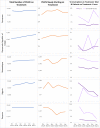Protecting the gains: analysis of HIV treatment and service delivery programme data and interventions implemented in 19 African countries during COVID-19
- PMID: 36419346
- PMCID: PMC9684677
- DOI: 10.1002/jia2.26033
Protecting the gains: analysis of HIV treatment and service delivery programme data and interventions implemented in 19 African countries during COVID-19
Abstract
Introduction: The potential disruption in antiretroviral therapy (ART) services in Africa at the start of the COVID-19 pandemic raised concern for increased morbidity and mortality among people living with HIV (PLHIV). We describe HIV treatment trends before and during the pandemic and interventions implemented to mitigate COVID-19 impact among countries supported by the US Centers for Disease Control and Prevention (CDC) through the President's Emergency Plan for AIDS Relief (PEPFAR).
Methods: We analysed quantitative and qualitative data reported by 10,387 PEPFAR-CDC-supported ART sites in 19 African countries between October 2019 and March 2021. Trends in PLHIV on ART, new ART initiations and treatment interruptions were assessed. Viral load coverage (testing of eligible PLHIV) and viral suppression were calculated at select time points. Qualitative data were analysed to summarize facility- and community-based interventions implemented to mitigate COVID-19.
Results: The total number of PLHIV on ART increased quarterly from October 2019 (n = 7,540,592) to March 2021 (n = 8,513,572). The adult population (≥15 years) on ART increased by 14.0% (7,005,959-7,983,793), while the paediatric population (<15 years) on ART declined by 2.6% (333,178-324,441). However, the number of new ART initiations dropped between March 2020 and June 2020 by 23.4% for adults and 26.1% for children, with more rapid recovery in adults than children from September 2020 onwards. Viral load coverage increased slightly from April 2020 to March 2021 (75-78%) and viral load suppression increased from October 2019 to March 2021 (91-94%) among adults and children combined. The most reported interventions included multi-month dispensing (MMD) of ART, community service delivery expansion, and technology and virtual platforms use for client engagement and site-level monitoring. MMD of ≥3 months increased from 52% in October 2019 to 78% of PLHIV ≥ age 15 on ART in March 2021.
Conclusions: With an overall increase in the number of people on ART, HIV programmes proved to be resilient, mitigating the impact of COVID-19. However, the decline in the number of children on ART warrants urgent investigation and interventions to prevent further losses experienced during the COVID-19 pandemic and future public health emergencies.
Keywords: COVID-19; differentiated care; retention; treatment; treatment interruption; viral suppression.
© 2022 The Authors. Journal of the International AIDS Society published by John Wiley & Sons Ltd on behalf of the International AIDS Society.
Conflict of interest statement
The authors report no competing interests.
Figures




References
-
- World Health Organization . WHO COVID19_Cases (arcgis.com). Geneva: WHO; 2021.
-
- El‐Sadr WM, Justman J. Africa in the path of COVID‐19. N Engl J Med. 2020;383:e11. - PubMed
-
- Geretti AM, Stockdale AJ, Kelly SH, Cevik M, Collins S, Waters L, et al. Outcomes of coronavirus disease 2019 (COVID‐19) related hospitalization among people with human immunodeficiency virus (HIV) in the ISARIC World Health Organization (WHO) Clinical Characterization Protocol (UK): a prospective observational study. Clin Infect Dis. 2021;73(7):e2095–106. - PMC - PubMed
Publication types
MeSH terms
Substances
Grants and funding
LinkOut - more resources
Full Text Sources
Medical
Miscellaneous

